Excess weight and obesity are the fifth biggest cause of mortality in adults, causing 2.8 million deaths per year worldwide (WHO, 2017). Future projections are not encouraging because, as the Organization for Economic Cooperation and Development (OECD) indicates, in 2020, two out of three people will be overweight or obese (Sassi, 2010).
In the Mexican context, in 2016, 72.5% of people over 19 years old were overweight or obese (National Institute of Public Health, 2016), reflecting a very large number of people who suffer from one of these conditions, even though many programs, campaigns and public policies focused on healthy and suitable diets have been developed to combat these conditions.
Current research on healthy behaviors requires the study of this problem and recommends multidisciplinary intervention. Therefore, psychology has tried to discover the causes for non-adherence to healthy eating by exploring possible variables that can lead an individual to achieve the successful maintenance of healthy behaviors.
It is important to mention that successful maintenance refers to the effort and work an individual invests in achieving a goal, despite the possible obstacles that can appear on the path to achieving it.
In this regard, there are several attributes and traits, such as creativity, energy, emotional intelligence, self-esteem and other positive qualities, that are considered essential for the obtention of individual success and achievement in specific areas, such as school, sport, and social contexts. However, some traits can be fundamental to success, regardless of the context or specific task (Duckworth, Peterson, Matthews, & Kelly, 2007). Success has historically been attributed to intelligence (Duckworth & Carlson, 2013), although some non-cognitive qualities, for example, Grit (Duckworth & Gross, 2014), have also been suggested to be determinants of success and have been overlooked in the study of certain contexts (Reed, Pritschet, & Cutton, 2013). Grit has been defined as passion and perseverance for long-term goals (Duckworth et al., 2007), and more recently it has been defined as the tenacious pursuit of a dominant superordinate goal despite setbacks (Duckworth & Gross, 2014).
Originally, the study of Grit arose in response to the question of why some people quit a task but other people with similar talents and capabilities achieve long-term goals. This attribute leads the person to work hard to overcome challenges, maintaining their effort and interest over the years, in spite of failures, adversities or stagnation (Duckworth et al., 2007).
Grit has shown predictive validity for success and performance in social contexts such as the military, jobs, and school (Duckworth, Kirby, Tsukayama, Berstein, & Ericsson, 2011; Duckworth & Carlson, 2013; Eskreis-Winkler, Shulman, Beal, & Duckworth, 2014; Wolters & Hussain, 2015). Thus, some authors have suggested that Grit could be a fundamental attribute in the achievement of high performance (Duckworth et al., 2007).
In order to measure Grit, Duckworth et al. (2007) developed the Grit Scale (Grit-O Scale), composed of 12 items distributed into two conceptual dimensions of six items each called consistency of interest and perseverance of effort. Consistency of interest is conceptualized as the stability of the interest in a certain goal or target across time, and perseverance of effort as the ability to sustain the effort when facing adversity (Duckworth et al., 2007). With the aim of improving the psychometric characteristics of the long version of the Grit Scale, Duckworth and Quinn (2009) presented a short version of the scale (Grit-S) with eight items distributed into the same two dimensions as the long version, consistency of interest and perseverance of effort, each consisting of four items. The psychometric characteristics of the short version confirmed the two-factor structure, its predictive validity, and the suitable internal consistency of the subscales and the entire scale.
Since the design of the Grit Scale, several adaptation and validity studies providing evidence of a bifactorial structure of the scale have been carried out across different cultural contexts such as Russia, Japan, Britain, Germany, Italy, The Philippines, China and Ghana among others (e.g., Abuhassàn & Bates, 2015; Datu, Valdez, & King, 2016; Lenz, Watson, Luo, Norris, & Nkyvi, 2018; Muenks, Wigfield, Yang, & O'Neal, 2017; Nishikawa, Okugami, & Amemiya, 2015; Schmidt, Fleckenstein, Retelsdorf, Eskreis-Winkler, & Möller, 2017; Sulla, Renati, Bonfiglio, & Rollo, 2018; Tyumeneva, Kuzmina, & Kardanova, 2014; Wang et al., 2017). However, Datu, Yuen and Chen (2017) validated a triarchic model of grit, where adaptability to the situation was an emergent factor for Grit assessment in Philippine culture, since non-significant results were found for the consistency of interest. Recently, the short version of Grit Scale was adapted and validated in the Spanish context by Arco-Tirado, Fernández-Martín and Hoyle (2018) and applied to adults with a mean age of 27.56 years. The results suggested that a one-factor structure be used, that is, without distinguishing between the two dimensions proposed in the original scale. More recently, Barriopedro, Quintana and Ruiz (2018) validated the short version of Grit Scale in Spanish adults (undergraduate students and athletes with a mean age of 20.93), considering grit to be a higher-order construct with two factors (consistency of interest and perseverance of effort). Likewise, the results of Li et al. (2018) supported a two-factor model with consistency of interest and perseverance of effort as first-order latent factors and Grit as a second-order latent factor. Given these structure differences, Credé, Tynan and Harms (2016) have recommended another approach for examining Grit's structure, appreciating the differences between a higher-order model and a model with two correlated factors.
To the best of our knowledge, no studies have adapted and/or used the Grit Scale in a Spanish-speaking context in Mexico; therefore, the application of the Grit Scale in a new country context will be one of the main objectives of the present study.
Recent Grit studies show that gritty people have determination and direction toward the achievement of long-term goals (Duckworth, 2016). This description is related to the theoretical nature of motivation, which entails energy, direction, persistence and equifinality, and aspects of activation and intention, suggesting that Grit and motivation are conceptually similar variables (e.g., Von Culin, Tsukayama, & Duckworth, 2014), Recently, Muenks et al. (2017) have found empirical support for the relationship between Grit and self-regulation (conceptually similar variables) in the educational context. These results lead us to hypothesize that there will be a significant relationship between Grit and different types of motivation.
One of the most important motivational theories, self-determination theory (Deci & Ryan, 2000, 1985; Ryan, 1995), has used the self-determination continuum to examine why some people commit to specific behaviors (e.g., following a healthy diet), and others do not. This continuum ranges from amotivation to intrinsic motivation, passing through different levels of extrinsic motivation. Amotivation or absence of regulation describes people with no intention of acting (Ryan, Williams, Patrick, & Deci, 2009). Extrinsic motivation is the least autonomous and refers to external regulation. These behaviors (e.g., healthy diet) are performed to satisfy external demands or to receive rewards (Deci & Ryan, 2000). Intrinsic or autonomous motivation describes people who become involved in an activity because it is interesting or enjoyable; that is, they have intrinsic regulation (Deci & Ryan, 2012).
When looking at healthy behavior (e.g., healthy diet), self-determination theory would help to coherently explain why people engage in certain healthy behaviors. However, it does not explain how people can be persistent over time and keep trying, despite obstacles or failures during this process. Therefore, Grit becomes important by providing an additional explanation for people's adherence to healthy behaviors.
In order to measure the self-regulation of a healthy diet, the Treatment Self-Regulation Questionnaire (TSRQ; www.psych.rochester.edu/SDT) was used. It was developed by Ryan and Connell (1989), and modified and adapted to the domain of health behaviors (e.g., diabetes, weight loss, quitting smoking). This questionnaire evaluates the degree of autonomous self-regulation (autonomous, controlled, and amotivation) with regard to the reasons people commit or would not commit to a healthy behavior. In a US population, Levesque and collaborators (2007) examined the TSQR's validity for three health-related behaviors (i.e., exercise, tobacco, diet). The confirmatory factorial analysis results were acceptable for the three data sets representing each of the healthy behaviors, with satisfactory fit indexes (CFI = .94 to .97; RMSEA = .06 to .09). Although this questionnaire has been used repeatedly in clinical practice, only one validation was found in the literature review, which is the study mentioned above. Therefore, adaptation and validation of TSQR in Mexican Spanish will be another aim of the current study.
In sum, Grit studies have been carried out in different performance areas, for example in the military, at university (for a meta-analytic review see Credé et al., 2017). However, none of the studies in the reviewed literature explored this personality trait in the area of health. This study aims to adapt and validate both the long and short version of the Grit Scale, as well as the TSRQ for diet, and explore the relationship between Grit and the different types of motivation for healthy eating behaviors in an adult Mexican population. Considering all this, we hypothesize that Grit, through consistency of interest and perseverance of effort, will have a positive relationship with autonomous motivation, and a negative relationship with controlled motivation and amotivation.
Method
Design and type of study
The present study has a non-experimental, quantitative and cross-sectional design, given that the study variables are not manipulated and are only used to find the psychometric properties of the studied instruments. In addition, it is a correlational study because it is designed to detect whether there is a relationship between the Gritty personality factors and the types of motivation (Hernández, Fernández, & Baptista, 2014).
Participants
The sample was composed of 353 adults (111 men, 241 women, and one who did not specify their gender), selected through convenience sampling, belonging to a metropolitan area of the state of Nuevo León, Mexico. The age of the sample ranged between 18 and 83 years old (M = 34.59; SD = 12.86).
Instruments
An adaptation of the Grit Scale (Grit-O Scale, Duckworth et al., 2007) in Spanish as spoken in Mexico was used. It contained 12 items divided into two subscales with six items each: consistency of interest (e.g., "I often set a goal but later choose to pursue a different one") and perseverance of effort (e.g., "I have achieved a goal that took years of work"). The responses were collected on a 5-point Likert-type scale from 1 (not like me at all) to 5 (very much like me). The results of the analysis of the original version (Duckworth et al., 2007) showed a two-factor solution with non-satisfactory indexes (RMSEA = .11 and CFI = .83) and suitable internal consistency for the total scale (a = .85), the consistency of interest subscale (a = .84), and the perseverance of effort subscale (a = .78). The short version of Grit Scale (Grit-S Scale, Duckworth & Quinn, 2009) contained eight items divided into two subscales with four items each (consistency of interest and perseverance of effort). The responses were collected on a 5-point Likert-type scale from 1 (not like me at all) to 5 (very much like me). The results of confirmatory factor analysis that tested the two-factor model showed satisfactory indexes (RMSEA = .06 - .10 and CFI = .86 -.96) (Duckworth & Quinn, 2009).
In addition, the Treatment Self-Regulation Questionnaire (TSRQ; Williams, Grow, Freedman, Ryan, & Deci, 1996) was used translated into Mexican Spanish and adapted for this study on healthy diet. The questionnaire was composed of 15 items, and its answers collected on a Likert-type scale ranging from 1 (not at all true) to 7 (very true). Six items assess autonomous motivation (e.g., "Because I feel that I want to take responsibility for my own health"), six assess controlled motivation (e.g., "Because I would feel guilty or ashamed of myself if I did not eat a healthy diet"), and three assess amotivation (e.g., "I really don't think about it"). The questionnaire starts with a sentence "I eat or would eat a healthy diet". Previous studies have shown suitable internal consistency for the three factors (alphas between .79 and .93), as well as an analysis of the factorial structure with acceptable indexes (CFI = .94 - .97; RMSEA = .06 - .09) (Levesque et al., 2007).
Procedure
The present study was conducted in accordance with international ethical guidelines consistent with the American Psychological Association. The procedure and instruments for this study were approved by the university's institutional review board. The translation of the instrument into Mexican Spanish was carried out following the translation and back-translation procedure (Hambleton & Kanjee, 1995). The translation was performed by a professional translation company hired by those in charge of the study. An expert group was created, consisting of three specialists with doctorates who worked in the field of sport and physical activity psychology. Two of them had experience in the validation of psychological instruments, and one was a translator specializing in this field. They discussed any discrepancies in the translation, until they finally achieved the first Mexican-Spanish version. This first version was translated back to English by another professional translation company different from that which was previously hired, and the two versions of the instrument were compared: the originals and the translations. The differences were analyzed again, and any necessary changes were introduced to facilitate the comprehension of the items, thus obtaining the final versions of the scales. The final version of the scales was applied to a group of students at Universidad Autónoma de Nuevo León to corroborate that there was no doubt about the language and wording of the scales.
Once the final versions of the scales were complete, four graduate students were trained to collect data; this training was carried out by the first author of the study at Universidad Autónoma de Nuevo León. The training covered the objectives of the study, the content of the scales and the application of the questionnaires to the study participants. The data collection at Universidad Autonoma de Nuevo León was only carried out with people who fully agreed to answer the survey. The data collection was personal, self-administered by the study participants and written in pencil. At all times, at least one research assistant accompanied the participants in case they had any questions. The questionnaires were filled out in a room at the university and took approximately 15 minutes to complete. All the participants signed an informed consent form assuring anonymity.
Statistical analysis
To examine the factorial structure of each instrument, confirmatory factorial analyses (CFA) were carried out. To analyze the fit of the CFA models, different indices of fit were considered, including the chi-squared value divided by the degrees of freedom (Χ2/df), the non-normative fit index (NNFI), the comparative fit index (CFI), and the root mean square error of approximation (RMSEA). A Χ2/df quotient of less than three indicates a good model fit (Cole & Maxwell, 1985). CFI and NNFI values above .90 indicate an acceptable fit (Hu & Bentler, 1999). For RMSEA, values between .05 and .10 are considered acceptable (equal to or less than .08 is satisfactory; Cole & Maxwell, 1985). Considering the ordinal nature of the data, the maximum likelihood estimation method was used, using as input for the analyses the polychoric correlation matrix and the asymptotic covariance matrix. The estimate parameters were considered significant when the associated t value was above 1.96 (p < .05).
The instruments' internal consistency was evaluated using Cronbach's (1951) alpha, Composite Reliability (CR), and the Average Variance Extracted (AVE). In general, alpha and CR values are considered adequate when they are equal to or greater than .70 and AVE values are above .50 (Hair, Black, Babin, & Anderson, 2010).
To test for possible differences between gender and age groups, a one-way multivariate analysis of variance (MANOVA) was conducted, with consistency of interest, perseverance of effort, autonomous motivation, controlled motivation and amotivation as dependent variables. Results revealed a non-statistically significant MANOVA effect between gender and age groups (Gender Wilks' lambda = .98, F (5,336) = 1.16, p = .33; Age Wilks' lambda = .93, F (20,1115) = 1.31, p = .16; Gender x Age Wilks' lambda = .92, F (20,1115) = 1.48, p = .08) and therefore subsequent analysis was conducted taking into consideration the whole sample. In this way, a Pearson correlation analysis was conducted to examine the relationships between grit factors and the motivation types, taking the total sample into account.
Descriptive, reliability, Pearson correlation and MANOVA analyses were conducted with the SPSS 22.0 statistical program. The CFAs were conducted with the LISREL 8.80 program (Jöreskog & Sörbom, 2006).
Results
The goodness of fit indexes of the Grit-O Scale, where the existence of two factors (consistency of interest and perseverance of effort) was hypothesized, were satisfactory: Χ2 (53) = 121.847, p < .05, Χ 2/df = 2.30, NNFI = .948, CFI = .968 and RMSEA = .064. All the factor loadings were significant (t values above 1.96). The correlation between the two factors was .24, indicating that, even though there is a significant relationship between them, they are independent, confirming the existence of two independent latent variables: consistency of interest and perseverance of effort. For the Grit-S Scale, the goodness of fit indexes for the bifactorial model were also satisfactory: Χ2 (19) = 42.319, p<.05, Χ2/df = 2.22, NNFI = .977, CFI = .985, and RMSEA = .063 (see Figure 1). All the factor loadings were significant (t values above 1.96) with the same values as the long version (see Table 1), with the exception of item 12 which corresponds to the perseverance of effort subscale which was .82. The correlation obtained between the factors was .48.
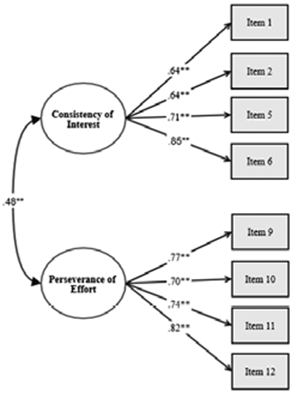
Note. Correlation index and all factor loadings are statistically significant (p < .01)
Figure 1 Confirmatory factor analysis of the gritty personality (Grit-S Scale)
Table 1 Descriptive statistics and factor loadings values for all the Grit Scale items (n = 353)
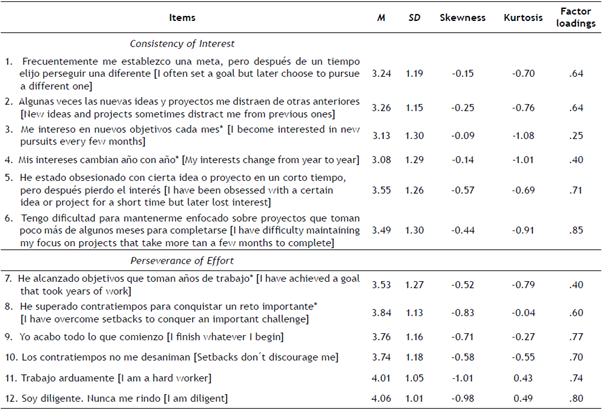
Note. All factor loadings are statistically significant (p < .01). *Items not considered for the short version of the Grit personality scale. Range 1-5.
In order to determine which of the two models (long version or short version) fit the data better, the differences between the goodness of fit indexes of the models were analyzed. For the CFI (Cheung & Rensvold, 2002) and NNFI (Widaman, 1985) indexes, differences between the models compared that are inferior to .01 are considered irrelevant; for the RMSEA index (Chen, 2007), the criterion specifies the irrelevance of differences inferior to .015. The results showed relevant differences between the fit of two indexes in the two versions of the instrument (ΔNNFI = .029, ΔCFI = .017, ΔRMSEA = .001); therefore, the short version is recommended because it presents better fit indexes.
In the case of the TSRQ, the goodness of fit indexes were acceptable: Χ2 (87) = 413.94, p < .05, Χ2/df = 4.75; NNFI = .90; CFI = .90; and RMSEA = .10, confirming the existence of three independent latent variables: autonomous motivation, controlled motivation, and amotivation (see Figure 2). The factor loadings of all of the models were significant (t values above 1.96). The correlations obtained between the factors were: .15 between autonomous motivation and controlled motivation, -.12 between autonomous motivation and amotivation, and .46 between controlled motivation and amotivation.
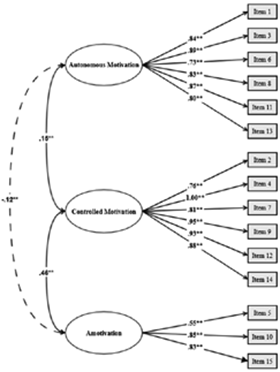
Note. Correlation indexes and all factor loadings are statistically significant (p < .01)
Figure 2 Confirmatory factor analysis of the TSRQ
Tables 1 and 2 show the descriptive analyses (means, standard deviations, skewness, and kurtosis) of the Grit Scale (Grit-O Scale and Grit-S Scale) and the TSRQ items for healthy diet. The factor loadings are above .40 in both scales. Standardized factor loadings for the Grit-O and Grit-S Scales were the same with the exception of item 12 that was .82.
Table 2 Descriptive statistics and factor loadings values for all the Treatment Self-Regulation Questionnaire items (n = 353)
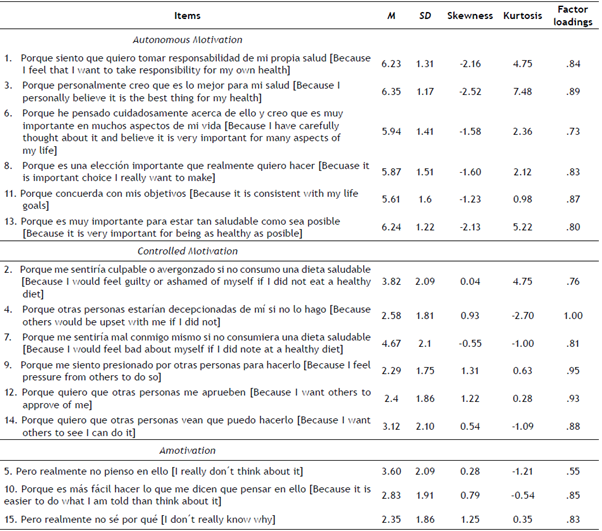
Note. All factor loadings are statistically significant (p < .01). Range 1-7.
Table 3 shows the descriptive analysis of the factors of the scales, as well as the correlations. The means of the Grit factors are located above the scalar mean. Regarding the means for the motivation subscales, amotivation presented the lowest mean, and autonomous motivation presented the highest mean. Consistency of interest was negatively related to controlled motivation and amotivation. In addition, perseverance of effort was positively associated with autonomous motivation and negatively with amotivation. Finally, the Grit total scale was positively related to autonomous motivation and negatively to controlled motivation and amotivation.
Table 3 Descriptive statistics and correlations of the Grit Subscales and Scale, and motivational types.
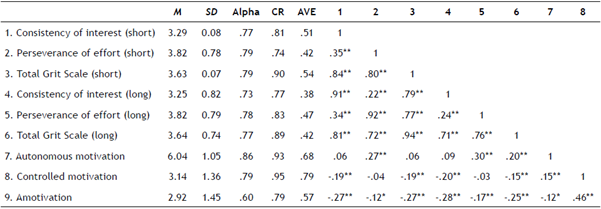
*p < .05; **p < .01 Range Grit Scale 1-5. Range motivational types 1-7
For both the Grit-S Scale and the TSRQ, the estimates of internal consistency were acceptable (> .70), except for the amotivation subscale that was .60. However, it has been argued that alpha coefficients of .60 can be considered acceptable in the case of established scales comprised of a low number of items (Hair et al., 2010; see Table 3).
Discussion
The aims of the current study were to adapt and validate the Grit Scale (comparing its long and short versions) and the Treatment Self-regulation Questionnaire for healthy diet in the Mexican context and discover the relationship between Grit factors and the types of motivation for healthy eating in a sample of the adult Mexican population.
Regarding Grit, it is important to mention that several studies have adapted the Grit Scale to their different cultural contexts; however, until now, the scale had not been adapted to the Mexican context. In the present study, the results confirm the two-factor structure of the scale (consistency of interest and perseverance of effort), and they show the adequacy of the data for the long version with 12 items and the short version with 8 items. Comparison of the two versions recommends the use of the shorter version (Rial, Varela, Abalo, & Lévy, 2006). These results are similar to those found by Duckworth and Quinn (2009), who obtained better fit indexes for the short version than for the long one. Also, several studies have found better indices for the grit structure with two related factors in both long and short versions (e.g., Abuhassàn & Bates, 2015; Datu et al., 2016; Lenz et al., 2018; Nishikawa et al., 2015; Schmidt et al., 2017; Sulla et al., 2018). In addition, the fit indexes found in the scale adapted to the Mexican context also coincide with those found by Abuhassàn and Bates (2015) and Datu et al. (2016) who obtained adequate fit for two factors with six items each. On the other hand, these results are different from those found by the two Spanish versions of the scale, since these versions did not obtain an acceptable fit of the data (Barriopedro et al., 2018), neither did the results support the use of overall scores in future research (Arco-Tirado et al., 2018). Given these findings, it is recommended to continue to explore Grit structure in a Mexican context.
With regard to the reliability analysis, in the two versions of the scale, both factors showed acceptable Cronbach alpha values, as well as composite reliability and average variance extracted. These three criteria together reflect the stability of the data obtained for the measurement of the Grit trait in the Mexican context.
For the Treatment Self-Regulation Questionnaire (TSRQ) for healthy diet, the literature review revealed no Spanish-language study that has used and validated the questionnaire, except the aforementioned study by Levesque et al. (2007), which also obtained acceptable values similar to those in the current study. This questionnaire has also been used in other contexts, such as tobacco addiction and exercise behavior, adapting the initial sentence of the questionnaire's title and items to the studied behavior, but maintaining the general structure of the sentence. In addition, it is important to highlight that this questionnaire is widely used in the clinical context with the objective of obtaining a general view of the patient's motivation, as part of the battery of tests administered to patients. The values obtained for the internal consistency of this questionnaire can be considered satisfactory.
In addition, the relationships found between Grit and the different types of motivation were significant in the expected direction. The relationship between perseverance of effort and autonomous motivation may be due to the fact that people who have a high level of autonomous motivation also tend to follow one path and persistently carry out a behavior that will later lead them to achieve the desired result. Ryan and Deci (2000) suggested that the nature of motivation is related to energy, direction, persistence and equifinality, and the data from the present study confirms this suggestion.
In the case of consistency of interest, no positive relations were found with autonomous motivation, but negative relations were found with controlled motivation and amotivation. Consistency of interest refers to the person's ability to remain focused on a goal and pursue it over time, a description that is conceptually different from autonomous motivation (Datu et al., 2017). However, it has been observed that while people are focusing on a goal, they have less controlled motivation levels and less lack of regulation.
It should be pointed out that the non-significant relationship between consistency of interest and autonomous motivation can be explained by the fact that individuals can have a certain stability towards an objective regardless of the type of motivation that draws them toward the behavior, in this case, a healthy diet. In other words, a person with autonomous motivation performs an act because they give it personal importance, are aware of the value of the action, feel agreeable toward it, and even enjoy it and receive inherent satisfaction from it, but this does not mean that they will maintain this behavior over time or seek achievement or success in this behavior. On the other hand, these non-significant results about consistency of interest are similar with the results found by Datu et al. (2017) who have mentioned that the cultural factor is important in Grit structure.
It is important to mention that, in this study, considering that the specific behavior studied was healthy eating, the question arises of whether the studied population performs this behavior autonomously, considering that the healthy eating behavior can be carried out due to external factors. In this regard, Levesque et al. (2007) explained that intrinsic motivation applies to situations where the behaviors are performed because they are interesting and enjoyable, and most people do not find health-related behaviors to be interesting and enjoyable.
The global score for Grit was positively related to autonomous motivation and negatively related to controlled motivation and amotivation, which means that people who have a higher overall level of Grit should have higher levels of autonomous motivation and lower levels of controlled motivation and amotivation. Duckworth (2016), in her description of Gritty people, mentions that they are determined and direct themselves toward achievement and success in their long-term goals, and that characteristics such as determination and direction are associated with the nature of motivation (Ryan & Deci, 2017), which indicates that Gritty individuals use autonomous motivational resources in order to achieve a result. These results agree with the hypothesis of the study that stated that Grit will be positively related to autonomous motivation, and negatively associated with controlled motivation and amotivation. Furthermore, these results provide evidence of the validity of the Grit Scale based on its relationship with other variables.
However, the absence of preliminary studies that have related the Grit trait to the types of motivation in a health context leads us to continue to explore these relationships, not only for type of motivation, but also for the type of regulation of motivation, which can facilitate a broader perspective for the analysis of the associations with healthy behaviors such as diet, weight control, and physical exercise.
One of the limitations of this study can be related to the sample's age range, given that it includes individuals from early adulthood to old age, and these variables may manifest differently depending on the developmental stages. Therefore, future studies should stratify and select the population randomly in order to determine whether age differences exist, or even carry out invariance studies by gender. In addition, Grit studies have been mostly cross-sectional until now, given that Grit is a trait that is just beginning to be explored in different contexts, as mentioned in earlier sections. Thus, it is important to know how this variable develops and is manifested through longitudinal studies, such as physical exercise or weight control programs where the studied groups are monitored. Finally, this personality trait should be explored with larger samples in order to better describe the factors involved and more closely examine the relationships established with the different types of motivation regulation. Then, intervention programs can be developed that help people to acquire autonomous motivation regulations that promote adherence to healthy behaviors.
In sum, it can be concluded that the Mexican version of the Grit Scale and the Treatment Self-Regulation Questionnaire for healthy diet are reliable instruments that adequately fit the Mexican-Spanish context and can be used in future research.














